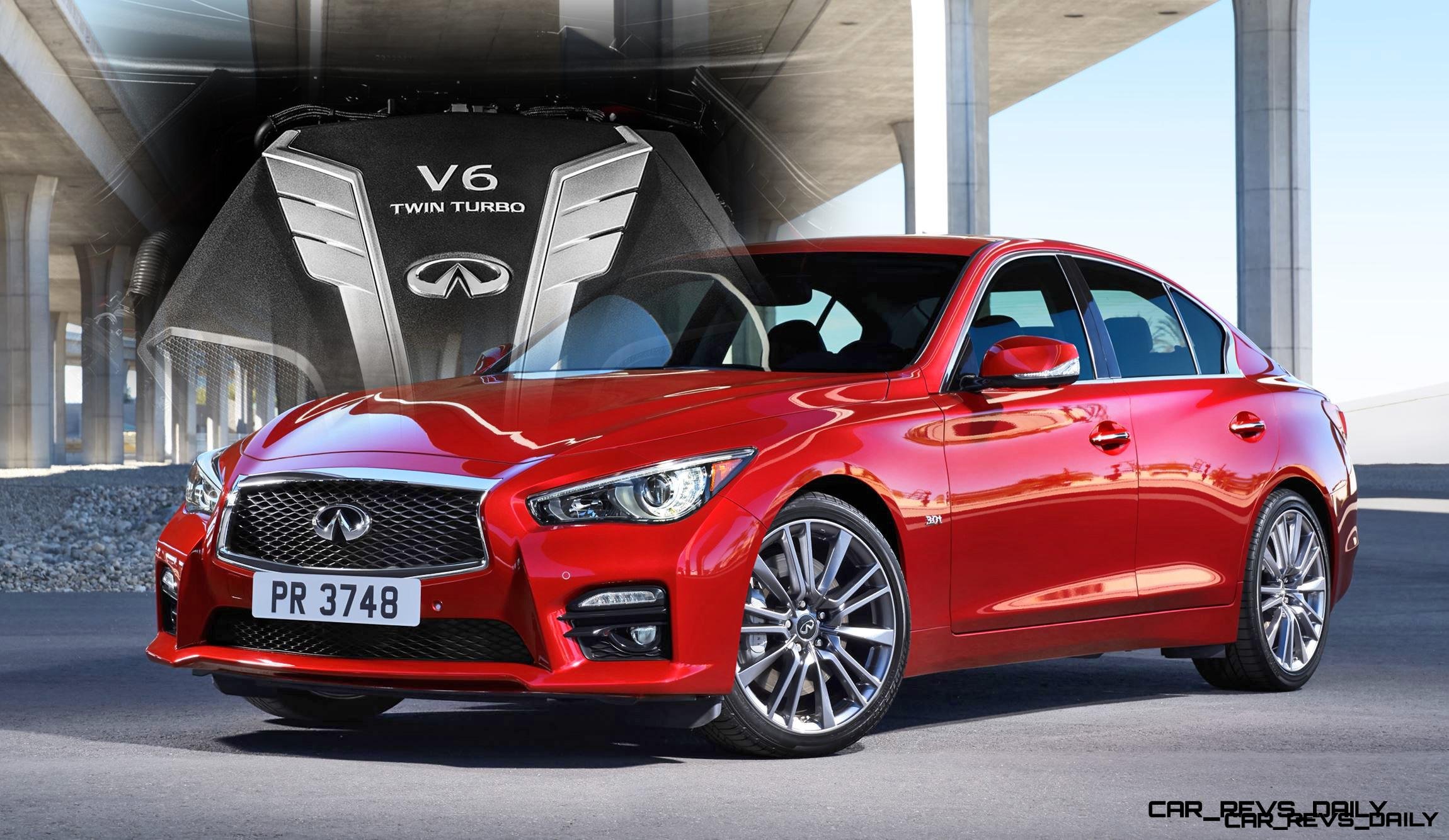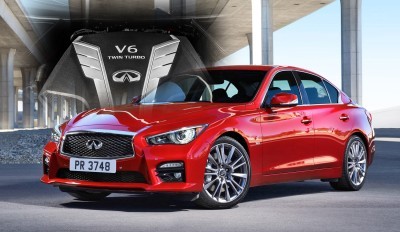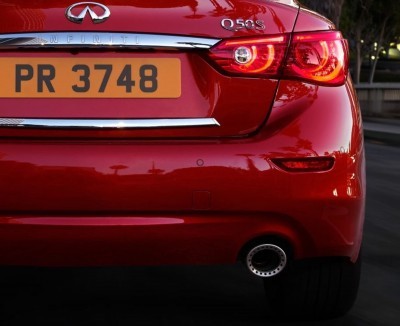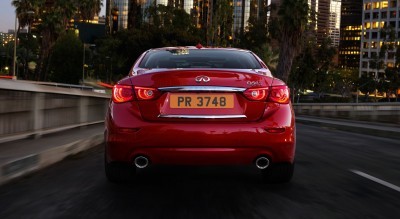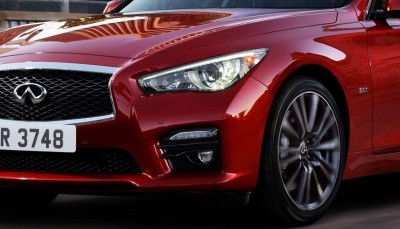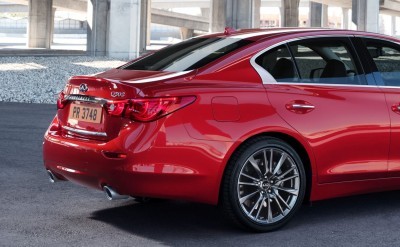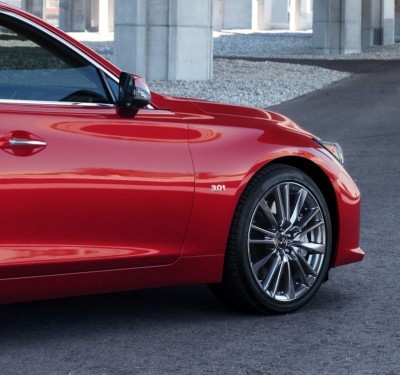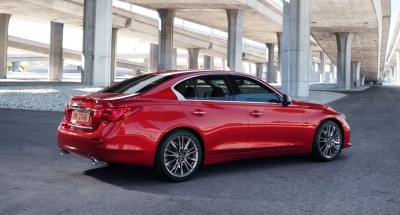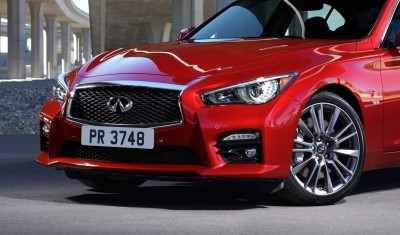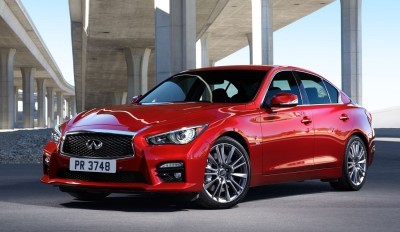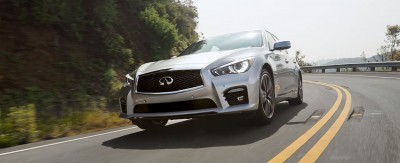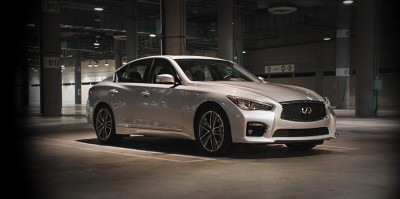 HUGE news on the Infiniti front today: An all-new pair of twin-turbo 3.0-liter V6s join the new 2.0-liter turbo four and 360HP hybrid. Dubbed the VR-series engines, the top output is the headline 400HP and 350-pound-feet of torque unit. This stump-puller will be offered in rear or AWD, with its torque starting a long plateau from just 1600-rpm.
HUGE news on the Infiniti front today: An all-new pair of twin-turbo 3.0-liter V6s join the new 2.0-liter turbo four and 360HP hybrid. Dubbed the VR-series engines, the top output is the headline 400HP and 350-pound-feet of torque unit. This stump-puller will be offered in rear or AWD, with its torque starting a long plateau from just 1600-rpm.
Kicking things off right is a limited-run model with giant alloys and sport cabin under the guise of Red Sport 400.
This badge steps in for Eau Rouge nicely!
No word on sprint pace, but the time should be comfortably in the 4’s — we’d ballpark a 4.7-second for the quickest new Q50.
The mid-range engine option is a single-waterpump version of the same displacement V6, but putting out 300HP and 295-pound-feet of torque. Both drop around 50-pounds from the front end versus the 3.7-liter unit they replace.
Along with the new engines comes very sporty new chassis tunes, adaptive and customizable drive programs, and enhanced ride control programs. All to keep the four-door buttoned down with so much new power!
The 2016 Q50 lineup with the huge new twin-turbos are arriving VERY soon, with a possible showroom arrival as soon as January 1st.
2016 pricing for the base 2.0-liter should slide in a bit below the current $37k total, with the Hybrid coming in from $44k as before. The new V6s are likely at $38k and $42k base prices — which is fantastic value versus the C400 and 340i for 2016, both of which are $50k and up.
2016 Infiniti Q50
Infiniti VR 3.0-liter V6 Twin-Turbo Specifications
Specifications are based on the latest product information available at time of printing
Mechanical
| Engine | 300 HP | 400 HP | ||
| Construction | V6 configuration, aluminium block with arc sprayed mirror coating to cylinder bores, aluminium cylinder head with
integrated exhaust manifold, lightweight resin and lower oil pan, compact twin direct-mount turbos, twin-intercoolers |
|||
| Displacement | 3.0-liter (2997 cc) | |||
| Bore & stroke | 86.0 x 86.0 mm | |||
| Cylinder Angle | 60 degree | |||
| Compression ratio | 10.3:1 | |||
| Cylinders | 6 | |||
| Valves | 24 (four per cylinder) | |||
| Valve control | Intake; electronic variable Valve Timing Control (VTC) Exhaust; hydraulic continuously variable VTC | |||
| Turbos | 2x turbo chargers with electronic wastegate actuator | |||
| Turbo control | – | Optical speed sensor | ||
| Turbo chargecooling | Twin water-to-air charge coolers with one water pump | Twin water-to-air charge coolers with two water pumps | ||
| Oil system | 0W-20 low viscosity oil. Electronically controlled variable displacement oil pump | |||
| Fuel system | High pressure multi-split direct injection gasoline (DIG), one injector per cylinder | |||
| Engine weight | 486.4 lb
220.6 kg |
|||
| Power | 300 hp
224 kW 304 PS @ 6,400 rpm |
400 hp
298 kW 405 PS @ 6,400 rpm |
||
| Torque | 295 lb-ft/400 Nm
@ 1,600-5,200 rpm |
350 lb-ft/475 Nm
@ 1,600-5,200 rpm |
||
2016 Infiniti Q50 sports sedan: New engines and chassis technologies deliver empowering performance and a more rewarding driving experience
- 2016 Q50 adds trio of new powerful and efficient turbocharged engines, including a 400-horsepower 3.0-liter twin-turbo V6
- Next-generation Direct Adaptive Steering™ (DAS) leads technology enhancements
- New Dynamic Digital Suspension (DDS) offers engaging ride and handing options
- New 400-horsepower Q50 Red Sport 400 heads line of five models in North America
NASHVILLE – The new 2016 Infiniti Q50 sports sedan is being launched with a number of performance and dynamic upgrades that deliver a more empowering and rewarding drive experience. The comprehensive updates include a trio of all-new advanced turbocharged engines, along with next-generation ride and handling technologies.
The Q50 – Infiniti’s top-selling model in North America – was developed from the outset to showcase Infiniti’s daring design, dynamic performance and class-leading technologies within the sports sedan segment. Now in its third year, Q50 global sales between January and October 2015 reached almost 50,000 models – representing a 65 percent increase compared to the same period in 2014.
Four advanced powertrain options are offered with the 2016 Infiniti Q50, including an all-new 3.0-liter V6 twin-turbo gasoline engine with direct injection. This new “VR30” engine is available in two states of tune: 400 horsepower or 300 horsepower – both developed to provide an ideal mix of drivability, efficiency and performance.
Also available on the Q50 is a new 2.0-liter four-cylinder turbocharged engine producing 208 horsepower, and a 360-horsepower hybrid powertrain, which combines a 3.5-liter V6 and a compact laminated lithium-ion battery with an innovative one-motor, two-clutch control.
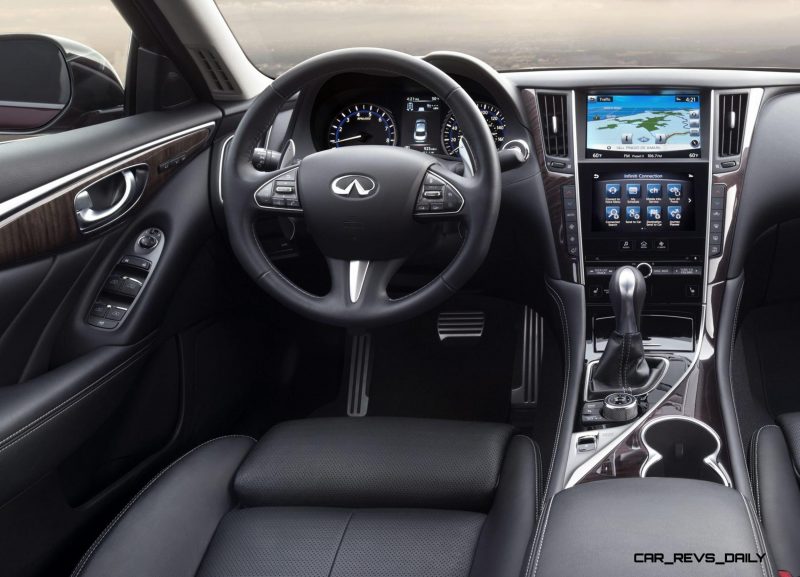
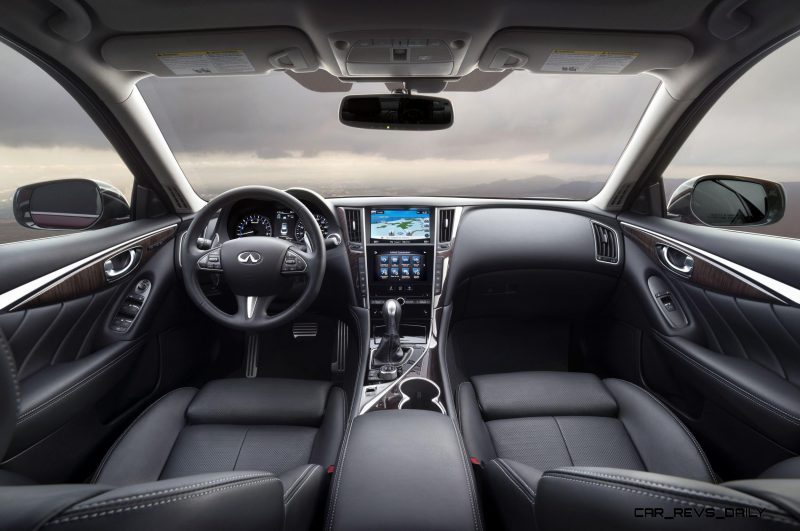
Also making its debut on the 2016 Infiniti Q50 is the Infiniti’s industry leading Direct Adaptive Steering, comprehensively modified from the groundbreaking first-generation system. Infiniti has enhanced the Direct Adaptive Steering after gathering customer feedback from around the world and completing 625,000 miles of real-world testing. The standard steering mode now offers advanced levels of steering feel and feedback – more akin to that of a conventional steering system. In addition, the upgraded system offers even more options to personalize and tailor the steering system’s levels of response and feel to suit the driver’s preferences.
The new Q50 also features Infiniti’s Dynamic Digital Suspension (DDS) for the first time, which gives the new Q50 sports sedan an optimal blend of ride comfort and class-leading response and agility. For drivers looking for a blend of dynamic settings tailored to their own particular requirements and tastes, the Q50’s Drive Mode Selector (DMS) can be augmented with “Personal” mode, which permits a tailored mix of engine, suspension and steering characteristics.
“The new Infiniti Q50 takes the core elements that have driven its global appeal to date, and now we have made it even better by offering a number of new and stand-out technologies. With the upgraded Q50, we are furthering Infiniti’s position on innovation.”
Francois Bancon, Infiniti Vice President Product Strategy
Infiniti’s most advanced V6 leads the refreshed engine line up
The all-new 3.0-liter V6 twin-turbo engine, from the new and exclusive “VR-series” powertrain family, has been developed to deliver optimal power and torque, alongside greater fuel efficiency. The high-output version of the power unit delivers 400 horsepower (298 kW) at 6,400 rpm and 350 lb-ft (475 Nm) maximum torque at 1,600-5,200 rpm. The standard output version produces 300 horsepower (224 kW) at 6,400 rpm and 295 lb-ft (400 Nm (295) torque at 1,600-5,200 rpm.
These outputs have been achieved while ensuring an expected improvement in fuel efficiency of up to 6.7 percent, representing a high power-to-efficiency ratio for the 400 horsepower power unit. This power-to-efficiency performance was made possible thanks to a combination of newly developed powertrain features.
An advanced new twin-turbo system contributes to the smooth and immediate power delivery while promoting gains in efficiency. The combination of a new turbine speed sensor and an optimized turbine blade design realize greater performance with more immediate response. The turbine speed sensor allows a 10 percent increase in turbine speeds, enabling the turbocharger to revolve at up to 220,000 rpm. With greater capacity for faster revolutions, the twin turbochargers enable the engine to deliver greater power and torque.
Advanced valve timing control incorporating a new electric motor mounted to the valve timing system delivers quicker reactions to driver inputs. Along with improved response, more immediate valve timing also helps the engine operate more efficiently, precisely controlling fuel and air quantities entering the combustion chamber.
A new high-pressure direct injection gasoline (DIG) system, introduced for the first time, allows for precise control of fuel injection into the combustion chamber depending on throttle position and current engine speed. DIG contributes significantly to making the new engine the cleanest and most efficient V6 that Infiniti has ever offered.
2.0-liter turbo and hybrid powertrains blend performance and efficiency
Complementing the new 3.0-liter V6 is a 2.0-liter four-cylinder turbocharged unit, producing 208 horsepower at 5,500 rpm with peak torque of 258 lb-ft (350 Nm) available from 1,500 rpm. This 1,991 cc unit has been engineered to achieve the same goals as the 3.0-liter V6 unit, blending response and performance with efficiency.
Direct injection and a high-efficiency compact turbocharger combine to achieve high levels of torque from low engine speeds for an enhanced driving experience. The high-pressure direct injection system with 200 bar piezoelectric injectors, multi-spark ignition and lean-burn combustion technologies also contributes significantly to efficiency. This is complemented by a variable camshaft design on the intake side, which enables a switchover from a standard cam for higher loads and engine speeds where increased power is required, to a “small” cam for partial engine loads.
In addition, to minimize friction losses on the small cam a maximum valve lift of 3.8 mm has been specified. The main advantage is a reduction of charge exchange losses and a nearly throttle-free operation in a relatively broad range of scenarios for exceptional efficiency.
A lightweight aluminum block and cylinder head with chain-driven dual-overhead camshafts, die-cast aluminum cylinder crankcase and optimized crank assembly promote further weight savings, reduce friction and improve efficiency. For the first time, the Q50 will offer an idle stop-start system (ISS) in combination with a 2.0- liter four-cylinder turbocharged engine.
The Q50’s advanced hybrid powertrain remains unchanged, featuring the Direct Response Hybrid® system with Intelligent Dual Clutch Control. It combines a 3.5-liter 24-valve DOHC aluminum-alloy V6 and a compact laminated lithium-ion battery with an innovative one-motor, two-clutch control. The system’s V6 is rated at 302 horsepower and 258 lb-ft of torque, while the advanced 50 kW electric motor is rated at 67 horsepower and 214 lb-ft of torque. The hybrid system net power is 360 horsepower, providing strong acceleration and lean fuel economy.
The hybrid powertrain is designed to put performance first, while bringing significant benefits for fuel efficiency. It takes full advantage of the electric motor’s instant torque for exceptional acceleration and, in combination with the 3.5-liter V6, provides an energetic feel under all driving conditions.
Smooth shifts from seven-speed automatic transmission
All 2016 Q50 powertrains are matched to an advanced seven-speed electronically controlled automatic transmission with manual shift mode and steering column-mounted magnesium paddle shifters.
Adaptive Shift Control enhances gear selection by using a lateral acceleration sensor to detect changes in the road, such as hills and turns. Sport mode allows the driver to select a more aggressive shift pattern with automatic up- and down-shifting at higher rpm. The combined effect is for any driver to enjoy quick, smooth shifts and gear choices that are appropriate to both the road and the desired driving style.
The new Q50 can be configured by the customer with one of two driveline options – rear-wheel drive or Intelligent All-Wheel Drive. Both are available with any of the four engines.
Dynamic performance from innovative technology
A range of new and innovative ride and handling technologies deliver on the promise of the Q50’s daring design and instill confidence in all driving conditions.
Infiniti Q50 models equipped with the new 3.0-liter V6 twin-turbo engine, or the hybrid powertrain, are available with the second-generation Infiniti Direct Adaptive Steering. The system has undergone significant re-tuning to enhance steering feel and feedback.
The changes to Direct Adaptive Steering – the world’s first digital steering system – have been made following extensive consultation with existing Q50 customers around the world and over 625,000 miles of testing.
For the new second-generation Direct Adaptive Steering, engineers have optimized the control logic to improve feedback from the road. They have fine-tuned parameters so that the default setting better mimics the feeling drivers are used to from conventional systems.
The new system also provides more customization options, fully utilizing the potential that Direct Adaptive Steering offers, giving drivers’ flexibility to choose the level of steering assistance and feedback according to personal preferences.
Direct Adaptive Steering actively adjusts the steering ratio and effort according to vehicle speed and scene. In slow-moving situations, such as city driving or parking, the system is tuned for ease of maneuverability.
In order to further enhance the steering feel in sporty driving conditions, the steering effort on the second generation Direct Adaptive Steering gradually saturates with high lateral G-force and acceleration in line with the overall vehicle behavior.
Direct Adaptive Steering is able to transmit the driver’s input to the wheels faster than a mechanical system while requiring fewer steering corrections and is able to make 1,000 steering adjustments per second. The new system enhances the steering feel by quickly and intelligently communicating to the driver feedback about road surface and chassis behavior. This gives the driver a secure and confident feeling at the wheel, free from unnecessary steering kickbacks or vibrations. The elimination of unwanted feedback has the further benefit of reducing driver fatigue.
The expanded selection of steering modes within Direct Adaptive Steering is accessed through the Drive Mode Selector (DMS). Located via menus displayed in the center console, Drive Mode Selector allows the steering response to be selected from six available options: Personal, Standard, Snow, Eco, Sport, and – new for the 2016 Q50 model – Sport+.
The Q50’s Personal steering mode allows for a high degree of fine-tuning. Drivers first select one of three core modes (Standard, Sport and Sport+) and then specify their preferred level of response (Default, Dynamic and Dynamic+). For a slower steering response and conventional feel, the driver would select a combination of Standard mode and Default response. For the highest level of assistance, the driver would choose Sport+ mode with Dynamic+ response – making best use of Direct Adaptive Steering technology.
The Sport mode of the Drive Mode Selector enhances the response of Direct Adaptive Steering, elevating the steering effort required while reducing the required steering movement from lock to lock. In the new Sport+ mode, steering effort remains the same as Sport mode, but the response of the steering is further increased, with an even quicker gear ratio for an enhanced performance feel. With both the Sport and Sport+ modes the result is an even greater sense of connection and control when the car is being put through its paces.
The new version of Direct Adaptive Steering works with Active Lane Control to maintain lane positioning against crosswinds and uneven road surfaces. This semi-autonomous capability is a precursor to future steering systems that will form a key building block on the way to achieving fully autonomous driving.
As standard, Q50 models equipped with the new 3.0-liter V6 twin-turbo engine feature Infiniti’s Rack Electronic Power Steering. This all-new system provides a linear and in-control driving experience that can be tuned through the Drive Mode Selector.
When making a steering input or returning the steering wheel following an input, traditional steering systems can create an unnatural feeling through imprecise control of the power assistance, reducing the feeling of linearity. To counter this, Infiniti’s Rack Electronic Power Steering precisely increases the steering effort required as the vehicle’s yaw rate changes, before adjusting to provide more assistance when the wheel returns towards on-center.
Infiniti Q50 2.0-liter models are equipped with a speed-sensitive hydraulic electronic rack-and-pinion power steering system as standard. This increases assistance at low speeds and reduces assistance for enhanced feel and response at higher speeds.
The Q50 features independent multi-link suspension and, for the 2016 model, revised suspension settings now provide an improved balance between confident handling and a comfortable ride. The front suspension is a double-wishbone design, while the revised rear suspension utilizes a multi-link design with coil springs and Dual Flow Path® shock absorbers. Extensive use of aluminum components for the suspension keeps weight down.
The Q50 now benefits from revised front and rear stabilizer bars. The result is heightening resistance to unwanted adjustments in the lateral movement of the suspension, affording a flatter ride and greater agility during cornering. The revised system is also better able to maintain contact between the tires and road.
All 2016 Q50 Sport models are upgraded with Dynamic Digital Suspension (DDS) for the first time, which offers enhanced ride comfort with class-leading response and agility. The shift from a comfort-biased ride to enhanced dynamic response can be made when the driver places the electronically adjustable shock absorbers in either Sport or Sport+ modes (adjusted via the Drive Mode Selector), providing firmer damping control for more agile handling. While in these modes, the suspension is constantly adjust¬ing to provide ideal performance and a flat ride.
In all modes, Dynamic Digital Suspension (DDS) also constantly adjusts the shock absorber valve within a wide range of damping force to control body motion when cornering. It monitors body roll, pitch and bounce rate to restrain body motion for a comfortable, confident and insulated ride in all conditions, ensuring that bumps and undulat¬ing road conditions are absorbed to maintain flat body posture.
Daring, expressive design
The Infiniti Q50 adds a new dimension of premium style to the sports sedan segment, thanks to its sleek proportions and athletic stance.
A strong first impression is created by Infiniti’s signature “double arch” grille. The grille’s three-dimensional, textural quality is provided by elaborate detailing of the waved mesh pattern surface and chrome surround, while the distinctive LED headlights and daytime running lights suggest an expressive form, almost like the human eye.
Rising from the double arch grille is a smooth yet commanding character line, which flows energetically through the body-side like a wave and merges with the rear, creating a highly fluid profile – a trademark Infiniti look.
Infiniti Q50 models equipped with the new 3.0-liter V6 twin-turbo 400 hp engine are designated as the Q50 Red Sport 400 and feature unique staggered 19-inch aluminum-alloy wheels and 245/40R19 front/265/35R19 rear summer performance run-flat tires, as well as unique exhaust tips. These changes help to assert the car’s performance credentials and add to its aggressive, confident aura.
New safety features
The new Infiniti Q50 builds on the long list of safety and security technologies already found in other Infiniti models, maintaining the car’s class-leading position.
The Technology Package adds Front Seat Driver/Passenger Pre-Crash Seatbelts; Blind-Spot Intervention (BSI); Lane Departure Warning (LDW); and Lane Departure Prevention (LDP) with Active Lane Control.
The new Driver Assistance Package includes features such as Forward Emergency Braking (EB); Blind-Spot Warning (BSW); Back Collision Intervention (BCI) with Cross Traffic Alert (CTA); Predictive Forward Collision Warning (PFCW); and Around View® Monitor (AVM) with Moving Object Detection (MOD).
Comfort and convenience features, customizable for a personal touch
Infiniti InTouch™ telematics system brings the future of in-car connectivity to the Q50 interior. Unlike conventional interfaces, the Q50 has not one but two touch-capacitive color screens (LCD/VGA 8-inch upper and 7-inch lower), with intuitive hand-gesture screen operation for easy changing of settings.
Along with the large dual screens, the Infiniti InTouch™ system is designed to effortlessly synchronize car and driver. Content and functions directed to the upper screen include the most frequently used applications, such as navigation maps. Other content is directed to the lower display screen.
In North America, the 2016 Infiniti Q50 is offered in a range of trim levels, each in a choice of rear-wheel or all-wheel drive – Q20 2.0t, Q50 2.0t Premium, Q50 3.0t Premium, Q50 Hybrid Premium, Q50 Sport and Q50 Red Sport 400.
New for Q50 in 2016 is the feature-rich Premium Plus Package, available on all engine options and including: auto dimming exterior mirrors; electric memory exterior mirrors; electrically adjustable steering wheel with memory and easy entry functions; Infiniti InTouch with navigation and one year of InTouch services; navigation-synchronized adaptive shift control; SiriusXM® Traffic; voice recognition; 60/40 split-fold rear seat with center armrest; electric lumbar support and position memory for the driver’s seat; heated steering wheel and heated front seats. For 3.0-liter Sport models, the Premium Plus Package also adds remote engine start.
The Technology Package has been revised to now include: Auto-leveling Adaptive Front Lighting System; High Beam Assist; Intelligent Cruise Control with full speed range; Distance Control Assist; Eco pedal; Advanced Climate Control System with Plasmacluster™ and Grape Polyphenol filter; as well as a range of safety features.
The new Infiniti Q50 goes on sale in selected markets later in 2016.
Please note: All product information contained in this press kit relates to global Q50 information, including technical specifications, powertrains and standard/optional equipment and features. Please contact your country’s Infiniti PR office for product details relevant to your market.
About Infiniti
Infiniti Motor Company Ltd. is headquartered in Hong Kong with sales operations in over 50 countries. The Infiniti brand was launched in 1989. Its range of premium automobiles is currently built in manufacturing facilities in Japan, the United States, United Kingdom and China. Infiniti plans to also expand manufacturing into Mexico by 2017.
Infiniti design studios are located in Atsugi-Shi, near Yokohama, London, San Diego and Beijing.
Infiniti is in the middle of a major product offensive. The brand has been widely acclaimed for its iconic design and innovative driver-assistance technologies.
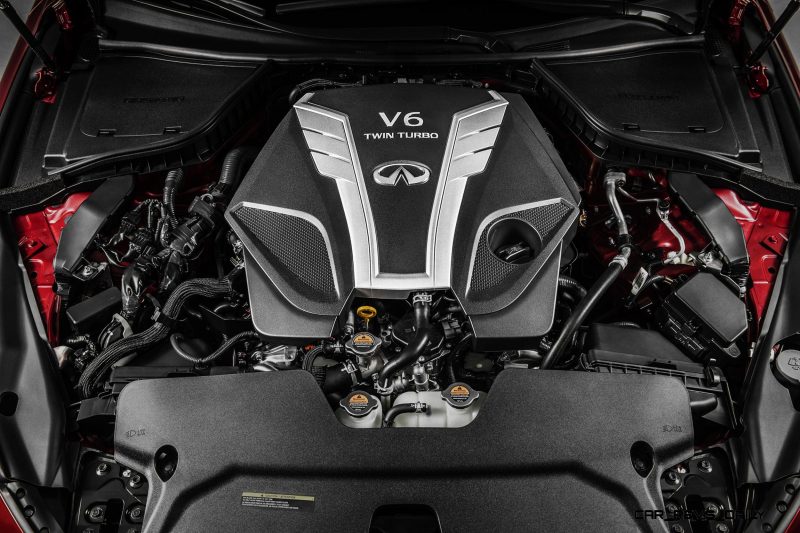
Infiniti announces new 3.0-liter V6 twin-turbo engine – the most advanced V6 ever offered by Infiniti
- New VR-series engine becomes the lightest, most powerful, cleanest and most fuel-efficient V6 engine that Infiniti has ever offered
- Two power outputs available: 400 or 300 horsepower
- Series of technical innovations enhance drivability and performance
- Compact layout features new integrated exhaust manifold
- The 3.0-liter V6 twin-turbo engine family will first be available in the 2016 Infiniti Q50 sports sedan
NASHVILLE – Infiniti’s new compact, lightweight 3.0-liter V6 twin-turbo engine is the most advanced V6 engine that the brand has ever offered, striking an ideal balance between drivability, efficiency, and performance.
The 3.0-liter V6 twin-turbo is an all-new engine from the new and exclusive VR-series powertrain family, born out of the brand’s longstanding heritage of V6 powertrain production. The new engine has been engineered to empower the driver and offer increased power and torque and higher levels of efficiency than any comparable predecessors from the company.
The engine’s reduced weight and contained size is credited, in part, to a lighter and more compact cylinder block. The result is greater mechanical efficiency, while a series of new features and in-house innovations secure superior performance.
Selected Infiniti models will be equipped with the all-new 3.0-liter V6 twin-turbo from 2016 onwards, with the engine available in two performance levels – 300 or 400 horsepower. Both engines share the same technologies and offer the same unrivalled sensation of potent and immediate power delivery.
The most advanced V6 engine Infiniti has ever offered
The all-new VR-series 3.0-liter V6 twin-turbo engines deliver a compelling combination of drivability, efficiency, and performance. The VR engines will be used in new Infiniti models that have been engineered to satisfy every Infiniti market worldwide, signaling the growing presence of the brand globally.
The all-new 3.0-liter V6 twin-turbo engine was created through extensive in-house experience of six-cylinder powertrain development and backed up by a strong history of V6 engine production. The VQ-series V6 powertrain family, predecessor to VR, has been a long-established and multi-award winning series of engines that has appeared in Infiniti models since 1994. For fourteen years, from 1995 to 2008, this VQ engine was listed as one of “Ward’s 10 Best Engines,” an unrivalled achievement.
New technologies for class-leading power output and efficiency
The all-new 3.0-liter V6 twin-turbo engine has been developed to deliver optimal power and torque for an engine of its size, together with optimized fuel efficiency. The high-output version of the power unit delivers 400 horsepower (298kW) at 6400 rpm and 350 lb-ft (475 Nm) maximum torque at 1600-5200 rpm; while the standard output version produces 300 horsepower (224kW) at 6400 rpm and 295 lb-ft (400 Nm) torque at 1600-5200 rpm.
While the 300 horsepower version is fitted with a single water pump, the 400 horsepower engine uses two water pumps for more effective management of heat when under operating at higher loads. In addition, for the 400 horsepower variant an optical turbo speed sensor gives a 30 percent power boost to the turbo system by allowing the blades to spin faster.
These outputs have been achieved while ensuring an improvement in fuel efficiency of up to 6.7 percent. This represents a best-in-class power-to-efficiency ratio for the 400 horsepower unit.
This power-to-efficiency performance was made possible thanks to a set of newly developed features. Advanced timing control ensures improved responsiveness, enabling quicker reactions to driver inputs.
A new electric motor is fitted to the valve timing system, increasing the speed of the throttle for enhanced response times. Not only does this have a positive impact on performance but also efficiency, with the engine able to operate more efficiently through closer control of cylinder combustion.
Power delivery is enhanced through an advanced new twin-turbo system enabling smooth and immediate responses under acceleration, while aiding efficiency. An optimized turbine blade design helps the engine generate greater overall performance, with faster turbine revolution speeds allowing for an immediate response from the twin-turbo system.
In addition, the V6 engine features a new turbine speed sensor, which allows for the twin-turbo system to perform at up to 220,000 rpm – at steady condition and 240,000 rpm at transient condition – higher than ever before for a V6 power unit. With greater capacity for faster revolutions, the twin turbochargers boost the higher-powered version of the engine to deliver higher power and torque. The turbo speed sensor on the 400 horsepower version allows for up to 30 percent more power output.
The engineers have developed a water-cooled intercooler system to further improve performance and efficiency. The system rapidly cools air as it enters the twin-turbo system, reducing turbo lag and allowing for more immediate acceleration. The secondary result is a cooling system that is more compact – meaning a shorter flow path for air entering the turbocharger to enable quicker engine response.
A new electronic wastegate actuator allows closer control of exhaust gas flow away from the turbocharger, restricting the amount of exhaust gas flowing through the unit to improve overall engine efficiency.
Lower weight, greater mechanical efficiency, more engaging drive
The core structure of the 3.0-liter V6 twin-turbo engine weighs 429.5 pounds (194.8 kg) – 39.1 pounds (14.1 kg) less than the engine it replaces. The new turbocharger and advanced intercooler (or CAC) system componentry adds just an extra 56.9 pounds (25.8 kg), for 486.3 pounds (220.6 kg) total.
The all-new power unit is 19 percent (0.7-liter) smaller in capacity than earlier V6 engines offered by Infiniti. It builds on the company’s legacy of embracing new engineering solutions and technologies. Just as these earlier engines have always been respected for their lightweight aluminum construction and low mechanical friction – making them smooth, durable and highly responsive – the 3.0-liter V6 twin-turbo engine follows its performance-oriented predecessors with a more compact and lightweight design, while maintaining a performance focus.
Chief among the new weight-saving elements is the adoption of spray bore coating for the engine block and integrated exhaust manifold for cylinder heads. Not only does this make the engine lighter, but this also aids cooling as heat can dissipate more effectively through the aluminum alloy bore wall, a process boosted further by its physical design, which encourages faster engine heat management.
The lower weight throughout the engine contributes to greater mechanical efficiency, with lower inertia from its lightweight aluminum components, while this added efficiency adds to the drivability and overall performance of the V6 engine.
The engineers have adopted a series of innovation technologies for application in the new V6 to deliver a more engaging driving experience. Chief among these is a new direct-injection gasoline (DIG) fueling system. The high-pressure DIG system allows for more precise injection of fuel into the combustion chamber, delivering the exact amount required for smooth engine acceleration, depending on throttle position and engine speed. This system makes the new V6 the cleanest and most fuel-efficient engine of its type that Infiniti has ever offered, contributing towards the 6.7 percent improvement in fuel economy.
The advanced valve timing control allows for more precise regulation of the fuel and air mix in the combustion chamber, helping the engine to operate more efficiently and improving fuel economy under all conditions.
The new cylinder-bore coating process further boosts mechanical efficiency. The new low-friction “mirror bore coating” technology allows the pistons to move more freely in the cylinders by reducing levels of mechanical friction by 40 percent compared to the previous V6 engines. This mirror bore coating process involves cylinder walls getting treated with a thermal arc spray coating after which the coating is hardened. The “mirror-smooth” cylinder wall reduces piston friction and boosts performance.
The mirror bore coating process saves the 3.0-liter V6 twin-turbo engine 3.8 pounds (1.7 kg) in weight, when compared to previous V6 engines, owing to the hardened tolerance that the spray system gives to lighter metals.
One of the most significant features in the all-new 3.0-liter V6 twin-turbo engine is the adoption of a new integrated exhaust manifold, built into the cylinder head, enabling engineers to position the catalytic converter closer to the exhaust point. This results in a shorter flow path for the hot exhaust gases, allowing the catalytic converter to heat up almost instantly – twice as fast as previous V6 engines – and reducing emissions from a cold start.
Moving the catalytic converter closer to the exhaust point saves weight by making the engine more compact than before. This design accounts for an 11.7-pound (5.3 kg) reduction in weight.
The new aluminum engine block has been constructed as a “square” engine, with equal cylinder bore and stroke dimensions (86.0 x 86.0 mm). As a result, the 3.0-liter V6 twin-turbo engine combines low mechanical friction and fast-revving response. Power and torque are accessed across a broader spread of mid-range engine speeds, in which drivers typically spend most of their time. The result is, the ideal balance between drivability, efficiency, and performance.
New V6 engine to enter production in 2016
The all-new 3.0-liter twin-turbo V6 engine is due to enter production during 2016 and will be manufactured at the powertrain plant in Iwaki, Fukushima, Japan. The first application of the engine family will be in the 2016 Infiniti Q50 sports sedan, which will be in Infiniti showrooms in North America beginning in late winter.
About Infiniti
Infiniti Motor Company Ltd. is headquartered in Hong Kong with sales operations in over 50 countries. The Infiniti brand was launched in 1989. Its range of premium automobiles is currently built in manufacturing facilities in Japan, the United States, United Kingdom and China. Infiniti plans to also expand manufacturing into Mexico by 2017.
Infiniti design studios are located in Atsugi-Shi, near Yokohama, London, San Diego and Beijing.
Infiniti is in the middle of a major product offensive. The brand has been widely acclaimed for its iconic design and innovative driver-assistance technologies.
More information about Infiniti and its industry leading technologies can be found at www.infiniti.com. You can also follow us on Facebook, Twitter, LinkedIn and see all our latest videos on YouTube.

Tom Burkart is the founder and managing editor of Car-Revs-Daily.com, an innovative and rapidly-expanding automotive news magazine.
He holds a Journalism JBA degree from the University of Wisconsin – Madison. Tom currently resides in Charleston, South Carolina with his two amazing dogs, Drake and Tank.
Mr. Burkart is available for all questions and concerns by email Tom(at)car-revs-daily.com.

